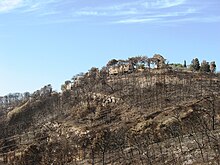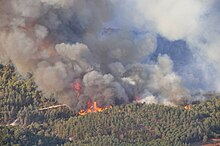Forest fire in Israel 2010


The 2010 forest fire in Israel was the largest in the country's history.
On December 2, 2010, the largest forest fires in the history of the State of Israel broke out. 44 people died and many were injured in the fires in the Carmel Mountains in northern Israel.
Fire development and course
November 2010 saw the highest temperatures in Israel in 60 years. Even in December it was still possible to swim in the Mediterranean . 2010 threatened to be the seventh year of drought in a row. It had not rained this winter before the fire broke out. Under the still green pine trees in the Carmel Mountains in the hinterland of Haifa stood easily combustible, dry undergrowth. The fires were fanned by rising sea breezes and spinning winds.
On December 2nd, a small fire broke out in the northwest of the mountains. There were several small fires, said a police spokesman later. This quickly developed into a wildfire that eventually reached the outskirts of Haifa. Southern parts of the city were evacuated, but many residents returned on their own. By December 4, 2010, rescue workers had evacuated 17,000 people from villages and kibbutzim in the affected areas. In Bet Oren , Ein Hod , Nir Etzion, Jemin Orad and Usfija several houses went up in flames. Damon Detention Center was also in the aisle that the fire ate. Forty-one law enforcement officers, most of them in training, were killed while trying to escape the flames on a bus after escorting around 500 prison inmates to safety. Due to the poor visibility, the bus could no longer continue and was trapped in a firestorm by the changing winds, which only three occupants survived. The chief of police in Haifa, Ahuva Tomer, drove directly behind the bus. She suffered severe burns and died a few days later in Haifa's Rambam Hospital . Furthermore, two emergency services were killed.
Residents of some villages and a suburb of the coastal city of Haifa were able to return to their homes and apartments on December 5, 2010. On December 6, 2010, it rained for the first time in eight months in the Carmel Mountains. He helped put out the last of the fires. The evacuated residents of the villages in Carmel were able to return to their homes.
About 35 km² of forest were destroyed within two days. More than 40 percent of the flora and fauna in the Carmel Mountains were destroyed. A police spokesman said the fire burned everything down on an area of 50 of the region's 120 square kilometers. An estimated 5 million trees fell victim to the flames.
From the Chai Bar Karmel Nature Conservation Center, animals were released into the surrounding forest area by opening the gates to enable them to escape from the flames.
Extinguishing measures
Fire-fighting units from all over Israel were brought together, on December 3, 2010 around 1550 men. In addition, the Israeli army was deployed, so that on December 4, 2010, more than 3,000 firefighters and soldiers fought the fire. Villages were evacuated by the police because residents refused to abandon their homes.
Around 30 countries sent aid to Israel at the request of Prime Minister Benjamin Netanyahu . On December 5, Netanyahu thanked Palestinian President Mahmoud Abbas for the aid provided by Palestinian firefighters with equipment. The neighboring Arab countries of Jordan and Egypt sent firefighters and extinguishing agents . The Turkey sent after mediation of the German Federal Chancellery two fire-fighting planes . Other countries also sent extinguishers on December 3, 2010 : ten fire-fighting planes and three helicopters came from France , Greece , Russia and Cyprus . The Swiss Air Force participated with three Cougar helicopters. The US government sent the Evergreen Supertanker, a large fire-fighting aircraft . It can hold up to 80 tons of extinguishing agent and can also fly at night. The tanker is a converted Boeing 747 and is otherwise used in the US state of California to fight forest fires. The Major General of the Israeli Air Force Ido Nehuschtan welcomed the foreign aid workers at Ramat David Air Base . Most of the fire-fighting planes used the air base as a base.
On the morning of December 5, 2010, more than 30 firefighting planes from Greece, France, Cyprus, Great Britain , Turkey , Russia and Italy resumed their work. Around 450 Israeli firefighters were now on the ground. They were supported by almost a hundred firefighters from Bulgaria and some Jordanian colleagues who had arrived . 20 Palestinian firefighters with four fire engines were also on duty.
The German federal government provided extinguishing agents, as well as two transport helicopters and an antidote for cyanide poisoning that can occur in fires.
Since there was a lack of fire-fighting planes with the appropriate capacity, small propeller guns from Israeli agriculture were used, which are otherwise used to control insects. The machines sprayed fire retardant chemicals.
root cause
The cause of the fire initially remained unclear. Israeli police arrested two suspect youths from the Druze village of Ussefiya near Isfiya on suspicion of negligent arson. It later emerged that the youths were responsible for the main fire. They had lit fire in the forest for a water pipe , the sparks of which set the parched trees on fire. The first source of the fire was reported to the fire department a little later. Media reports that the fire might have broken out in an illegally created garbage dump in the mountains were not confirmed.
Natural and environmental damage

The Carmel Mountains are known as the “Tuscany of Israel”, as pine forests grow on the slopes of the mountains and it gets very hot in summer. Many of the forest areas were not afforested until the 1930s and 1940s. The Carmel Mountains are home to a wide variety of flora and fauna and are well developed with hiking trails. Some areas are under nature protection. Many Israelis use the region for hiking and day trips.
About five million trees burned down in the four days of the fire. 40 percent of the forest in the Carmel Mountains was destroyed. Only seven percent of Israel is forested. The Carmel Forest made up more than two thirds of this area. After the fire, one of the four government-appointed commissions dealt solely with the reforestation of the forest on Mount Carmel.
The largest nature conservation company in Israel, the SPNI , called on the Israeli government on December 6, 2010 to leave the areas destroyed by fire largely to themselves. According to a report by SPNI, this region has the ability to regenerate from its own resources and should not be restored by unnecessary planting of trees. This should avoid repeating mistakes made in the first major planting campaigns in the past. Previous fires in Israel have led to insights into how to treat burned regions, according to the SPNI. According to the report, there are enough seeds in the soils of the affected areas to be able to renew the region in various ecological ways. New plantings should only be carried out after ecological evaluations and, if necessary, only in small areas. For example, the pine trees that encouraged the fire to spread were not native to the region. According to the SPNI, the burned trees should not be removed to prevent soil erosion . When heavy machinery is used, the soil and the first primary vegetation after the fires are severely damaged.
criticism

The fire brigade's teams did not arrive until two hours after the first fire had been reported.
At the time the fire broke out, Israel did not have its own fire-fighting aircraft . The supplies of fire retardants ran out on the first day after the fire broke out. There was also no operational plan for a fire of this magnitude. The Israeli fire brigade has been complaining about under-staffing and outdated equipment for years. During the forest fires, the fire brigade had insufficient and outdated extinguishing equipment. Prime Minister Netanyahu said that fire fighting should in future be carried out from the air by a separate fire brigade. Israeli media criticized authorities and the state, as the country had focused too much on the military defense and civil protection have neglected.
After the fire was extinguished, the Israeli media criticized Interior Minister Eli Yishai (Shas party). Jischai, who already held the post of interior minister in the previous government, was responsible for the fire brigade in Israel. In the media, he was accused of failing to improve the fire brigade's poor equipment and of having too few firefighters available. In Israel there was one firefighter for every 6,500 inhabitants at the time of the fire, while in Western countries there was an average of one firefighter for every 1,000 inhabitants.
The government set up four commissions on December 6, 2010, one of which was to help the victims of the fire. 70 houses were totally destroyed and have to be rebuilt. Another 180 buildings were damaged. A cabinet secretary said with regard to those who had become homeless that the Israeli state would first provide mobile homes or some other satisfactory solution. The residents should be informed about permanent housing solutions within 60 days and a corresponding program should be set up.
Web links
Individual evidence
- ↑ Surrounded by flames. In: sueddeutsche.de. December 3, 2010, accessed July 28, 2018 .
- ↑ Israel: Many people die in forest fires. In: Spiegel Online . December 2, 2010, accessed June 10, 2018 .
- ↑ - ( Memento of the original from December 7, 2010 in the Internet Archive ) Info: The archive link was automatically inserted and not yet checked. Please check the original and archive link according to the instructions and then remove this notice.
- ↑ http://www.tagesschau.de/ausland/israel956.html ( Memento from December 6, 2010 in the Internet Archive )
- ↑ First rain - forest fires extinguished
- ↑ http://www.tagesschau.de/ausland/israel970.html ( Memento from December 8, 2010 in the Internet Archive )
- ↑ dapd / dpa / lk: big fire: possible cause of fire arrested in Israel. In: welt.de . December 4, 2010, accessed October 7, 2018 .
- ^ Radio report by ARD correspondent Martin Engelbrecht on December 4, 2010
- ↑ Forest fires in Israel: Police arrest two suspects. In: Spiegel Online . December 4, 2010, accessed June 10, 2018 .
- ↑ http://www.israelmagazin.de/?p=7320
- ↑ http://www.n24.de/news/newsitem_6498284.html ( Page no longer available , search in web archives ) Info: The link was automatically marked as defective. Please check the link according to the instructions and then remove this notice.
- ^ Radio report by ARD correspondent Martin Engelbrecht on December 4, 2010
- ↑ http://www.tagesschau.de/ausland/israel974.html ( Memento from December 7, 2010 in the Internet Archive )






